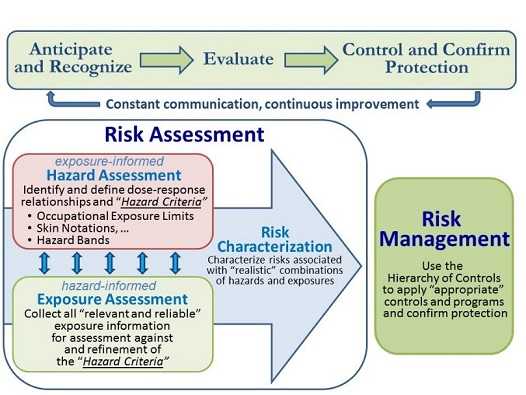Exposure Assessment Program
Program Description
Exposure Assessment is the multi-disciplinary field that identifies and characterizes workplace exposures, develops estimates of exposure for exposure-response and risk assessment studies, and evaluates the significance of exposures and effectiveness of intervention strategies. Exposure assessment plays a central role in risk management, as depicted in the graphic below.

Thus, occupational exposure assessment enables effective anticipation, recognition, evaluation, control, and confirmation of protection from workplace hazards. Throughout the entire process, there is an iterative interaction between exposure-informed hazard assessment, hazard-informed exposure assessment, and risk characterization and management. At each stage, health professionals consider the available information and develop a course of action that may include continuing along the original exposure assessment process, determining that no further action is required, performing additional hazard identification, refining the exposure assessment, or improving or adding engineering and/or administrative controls.
Exposure assessment formally became a program at NIOSH in 2006, but has been a critical area of research and practice since the Institute was created in 1970. To keep pace with the evolving health risks and challenges facing U.S. workers and employers, NIOSH researchers across the Institute have developed, published, and applied effective exposure assessment methods that have made it increasingly possible to achieve and confirm protection from those existing and evolving risks. Over the last twenty years, EXAP has matured from identifying the gaps and challenges to developing new strategies and tools.
In recent years, the Exposure Assessment Program has developed and commercialized low cost methods to detect methamphetamine in the field and provided scientific expertise and assistance during national emergencies such as Hurricane Katrina and the BP oil spill (Deep Water Horizon). The program has also conducted foundational work that paved the way for control banding approaches to the qualitative risk characterization and management of occupational hazards.
- Page last reviewed: October 6, 2017
- Page last updated: October 16, 2017
- Content source:
- National Institute for Occupational Safety and Health Respiratory Health Division


 ShareCompartir
ShareCompartir